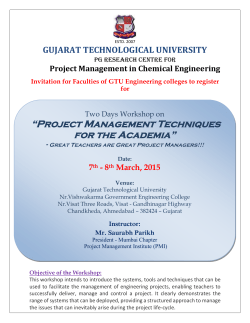
AEIOU and LNM Theory - Gujarat Technological University
Post-graduate Research Centre for Industrial Design OPEN Student Start-up Support System (S4) DESIGN SCHOOL Gujarat Technological University (GTU), Ahmedabad GTU Innovation Council (GIC) Design Engineering – IB In the Guidelines, a reference has been made to the AEIOU framework. AEIOU Framework: (Paper size A3) AEIOU is an investigative tool to help interpret observations gathered by ethnographic practices in the field. It is an Observation tool. Its two primary functions are to code data, and to develop building blocks of models that will ultimately address the objectives and issues of a client. AEIOU stands for 5 elements to be coded: Activity, Environment, Interaction, Object, and User. Activities are goaldirected sets of actions—paths towards things people want to accomplish. What are the modes people work in, and the specific activities and processes they go through? Please see 1_AEIOU_Activities. 1 |Gujarat Technological University (GTU) (http://www.gtu.ac.in/) | |GTU Innovation Council (GIC) (http://www.gtuinnovationcouncil.ac.in) | |Contact: ap_karmjitsinh@gtu.edu.in; ap_gagandip@gtu.edu.in; gic@gtu.edu.in| Post-graduate Research Centre for Industrial Design OPEN DESIGN SCHOOL Environments include the entire arena where activities take place. What is the character and function of the space overall, of each individual's spaces, and of shared spaces? Please see 2_AEIOU_Environment. Interactions are between a person and someone or something else; they are the building blocks of activities. What is the nature of routine and special interactions between people; between people and objects in their environment, and across distances? Please see 3_AEIOU_Interaction. Objects are building blocks of the environment, key elements sometimes put to complex or unintended uses (thus changing their function, meaning and context). What are the objects and devices people have in their environments and how do they relate to their activities? Please see 4_AEIOU_Objects. 2 |Gujarat Technological University (GTU) (http://www.gtu.ac.in/) | |GTU Innovation Council (GIC) (http://www.gtuinnovationcouncil.ac.in) | |Contact: ap_karmjitsinh@gtu.edu.in; ap_gagandip@gtu.edu.in; gic@gtu.edu.in| Post-graduate Research Centre for Industrial Design OPEN DESIGN SCHOOL Users are the people whose behaviours, preferences, and needs are being observed. Who is there? What are their roles and relationships? What are their values and prejudices? Please see 5_AEIOU_Activities. Process Information/Data are gathered via ethnographic methods: notes, photos, videos, interviews, field observation, etc. During field observation, use the AEIOU framework as a lens to observe the surrounding environment. Record observations under the appropriate headings. Supplement direct observations with photos or video tape when appropriate. Review and cluster observations to disseminate higher-level themes and patterns. References: http://www.drawingideasbook.com/images/AEIOU_worksheets.pdf http://www.doctordisruption.com/design/design-methods-8-aeiou/ Learning Needs Matrix (LNM): (Paper size A2) Learning Needs Matrix will help students to identify the learning requirements at an early stage along with prioritization of specific learning along with defined time duration/ time allocation for each learning priority. 3 |Gujarat Technological University (GTU) (http://www.gtu.ac.in/) | |GTU Innovation Council (GIC) (http://www.gtuinnovationcouncil.ac.in) | |Contact: ap_karmjitsinh@gtu.edu.in; ap_gagandip@gtu.edu.in; gic@gtu.edu.in| Post-graduate Research Centre for Industrial Design OPEN DESIGN SCHOOL Identification will be focused on listing out both (i) the learning, which is included in some subject of the formal syllabus of your branch and (ii) the learning, which is required for solving the Design problem and which may not be included in the formal syllabi of the other subjects. All such learning, required for developing the product, should be considered to be required to be studied for the group of students, who are working on the product. It may include learning of specific skills. Please see 6_LNM. General Instructions for LNM: • Students are to identify requirements in each four heads • Priority learning shall be taken up in Sem. IV of BE 2nd year (At least one from any of the four quadrants by each student) • By the end of BE 3rd year Students will be developing working model. By that time, most of all quadrants shall be covered under learning. • Supportive aspects (with least priority) shall be placed in BE 4th/final year. • Choice of learning lies with faculty guide and student group to identify prioritization and set learning time line targets… 4 |Gujarat Technological University (GTU) (http://www.gtu.ac.in/) | |GTU Innovation Council (GIC) (http://www.gtuinnovationcouncil.ac.in) | |Contact: ap_karmjitsinh@gtu.edu.in; ap_gagandip@gtu.edu.in; gic@gtu.edu.in|
© Copyright 2025









